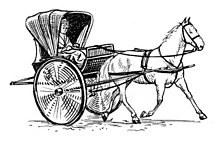Chaise


A chaise (/ʃeɪz/ shayz), sometimes called chay or shay, is a light two- or four-wheeled traveling or pleasure carriage for one or two people with a folding hood or calash top.[1] The name, in use in England before 1700, came from the French word "chaise" (meaning "chair") through a transference from a sedan-chair to a wheeled vehicle.[2]
Design[edit]
The two-wheeled version, usually of a chair-backed type, for one or two persons, also called a gig or one-horse shay, had a body hung on leather straps or thorough-braces and was usually drawn by one horse; a light chaise having two seats was a double chair.
A chaise-cart was a light carriage fitted with suspension, used for transporting lightweight goods.[1]
A bath chair was a hooded and sometimes glassed wheeled chair used especially by invalids; it could be drawn by a horse or pushed by an attendant.

Other types of chaise included:
- post chaise : designed for fast long-distance travel;
- curricle: two-wheeled, usually drawn by two horses;
- calesín: small, one-horse, hooded, a seat behind for the driver, used in the Philippines;
- shandrydan or shandradan: with a hood;
- riding chair is a chaise body with no top.[3]
During the winter of 1791/92, in the opening phases of the French Revolution, Henrietta Ponsonby, Countess of Bessborough, noted the lack of ostentation in the streets of Paris, where a few drove themselves about in "little open chaises like the cabriolet but with one horse."[4]
See also[edit]
References[edit]
- ^ a b Cowie, L.W. (1996). The Wordsworth Dictionary of British Social History. Wordsworth Reference. p. 55. ISBN 1-85326-378-8.
- ^ Chisholm, Hugh, ed. (1911). . Encyclopædia Britannica. Vol. 5 (11th ed.). Cambridge University Press. p. 802.
- ^ Huntington, A.S. (1892). Under a Colonial Roof-tree: Fireside Chronicles of Early New England. Wolcott and West. p. 33. Retrieved 2023-11-26.
- ^ Janet Gleeson, Privilege and Scandal: The Remarkable Life of Harriet Spencer, Sister of Georgiana 2006:130.
